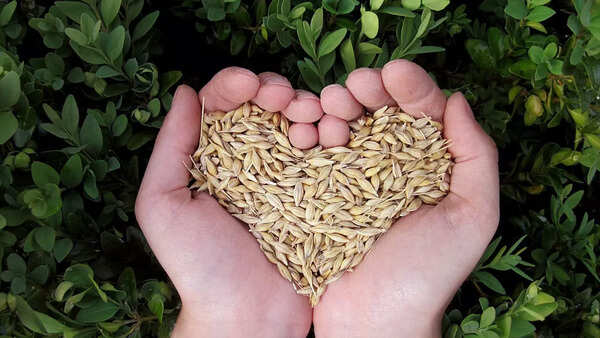How to identify “keede” in rice or grains: Prevention and hacks to remove them you must try
"Chawal keede," commonly known as rice weevils, are small, dark brown or reddish-black insects that frequently infest stored grains such as rice, atta, and dal. These pests are a prevalent nuisance in Indian kitchens and can lead to digestive issues if consumed. They thrive inside grains, feeding on them from within.
 *Source: Wikipedia*
*Source: Wikipedia*
When washing rice, you may notice tiny white larvae floating on the surface or small holes in the grains, indicating their feeding activity. These worms often flourish in damp and humid conditions, particularly during the monsoon season, which provides an ideal breeding environment. Once reproduction begins, eradication becomes challenging.
Identifying Rice Weevil Infestations
Regularly inspect rice and grain products for small, black or brown beetles, roughly half the size of a long grain of rice. Be vigilant for signs of infestation, such as sticky webs or silky strands accompanied by small clumps of broken rice, often found crawling within rice packets. These webs are created by rice weevil larvae and can be detected even before the insects themselves are visible.
Preventing Weevil Infestations in Grains
 *Source: Canva*
*Source: Canva*
Here are several effective methods to prevent weevils from infesting your grains:
- Store in airtight containers: Keep rice and grains in sealed glass or plastic containers to block weevils from entering. Weevils can penetrate paper, cardboard, and thin plastic packaging.
- Use natural repellents: Employ strong scents such as bay leaves, cloves, garlic, and crushed peppercorns to deter weevils. These spices contain natural compounds that repel weevils and prevent infestation.
- Check food before storing: Carefully examine dried food products before storing them in your kitchen, looking for silky webs or any indications of weevil contamination.
- Store in a cool, dry place: Keep rice and grains in a cool, dry environment or in the refrigerator. Weevils become inactive at temperatures below 55°F (13°C), inhibiting reproduction and infestation.
- Buy in small quantities: Purchase rice and grains in smaller amounts to minimize the risk of weevil infestations. Smaller quantities reduce the likelihood of weevils pupating and maturing into adult beetles.
- Check for silky webs: Inspect food packaging for silky webs, which may indicate a weevil infestation. If webs are present, it is advisable to discard the food.
- Maintain clean storage: Keep storage areas clean and regularly check for signs of weevil infestation. Proper storage and routine inspections can help prevent weevil infestations and maintain a pest-free pantry.
Simple Home Remedies to Eliminate Weevils from Stored Grains
Effective elimination strategies can help rid your kitchen of these pests, ensuring that your stored grains are safe and healthy for consumption.
- Dry rice in sunlight: Expose infested grains to direct sunlight to eliminate weevils. Spread the rice evenly on a tray or newspaper and leave it in the hot sun for several hours to kill the weevils and their eggs.
- Use a wet cloth trap: Cover the rice container with a damp cloth to trap weevils. Weevils are drawn to humidity and will adhere to the cloth. After 30 minutes, remove the cloth and clean the rice.
- Store in freezer: Freeze rice for three days to kill weevils and their eggs. Cold temperatures halt the weevil's development and prevent infestation.
- Airtight containers: Store rice in airtight containers to prevent weevil infestation. Clean, dry, and tightly sealed containers will cause weevils to die from lack of air.
- Bay leaves and Neem leaves: Place dried bay or neem leaves in a rice container to repel weevils. These leaves have natural properties and a strong scent that prevents infestation.
- Spice repellent: Use spices like ginger, cloves, and garlic to deter weevils. Place them in a rice container and replace them periodically. These spices emit strong aromas that weevils dislike.
- Dried orange peel: Chop dried orange peel into small pieces and sprinkle it into the rice container, particularly in areas where worms are present.
- Matchbox trick: Place an open matchbox near grains to repel worms. Matchboxes contain sulphur, which worms find unpleasant, keeping them away from grains.
Newer articles
Older articles
-
 Will Nysa Devgan enter Bollywood like Raveena Tandon's daughter Rasha Thadani? Kajol reveals the truth
Will Nysa Devgan enter Bollywood like Raveena Tandon's daughter Rasha Thadani? Kajol reveals the truth
-
 This new AI tool can help you book train tickets, get refunds and check details on IRCTC website and app
This new AI tool can help you book train tickets, get refunds and check details on IRCTC website and app
-
 Mahbub Anam replaces Faruque Ahmed as new BPL chairman
Mahbub Anam replaces Faruque Ahmed as new BPL chairman
-
 How do graphic designers convert JPG to PDF (Portable Document Format)?
How do graphic designers convert JPG to PDF (Portable Document Format)?
-
 Selena Gomez and Hailey Bieber UNFOLLOW each other amid Justin Bieber drama
Selena Gomez and Hailey Bieber UNFOLLOW each other amid Justin Bieber drama
-
 Suchitra Krishnamoorthi faces backlash for claiming Air India crash survivor was ‘LYING’; Deletes post and issues apology
Suchitra Krishnamoorthi faces backlash for claiming Air India crash survivor was ‘LYING’; Deletes post and issues apology
-
 Teen Innovator Soars to New Heights: Mehar Singh Breaks Guinness World Record with Lightning-Fast Drone Ascent
Teen Innovator Soars to New Heights: Mehar Singh Breaks Guinness World Record with Lightning-Fast Drone Ascent
-
 Still swooning over Ahn Hyo Seop and Kim Sejeong in ‘Business Proposal’? Here are 3 new K-Dramas to obsess over next!
Still swooning over Ahn Hyo Seop and Kim Sejeong in ‘Business Proposal’? Here are 3 new K-Dramas to obsess over next!
-
 'Would be remarkable to choose someone else if their last knock was a 170'
'Would be remarkable to choose someone else if their last knock was a 170'
-
 iQoo Z9 Turbo new leak reveals key specifications: All the details
iQoo Z9 Turbo new leak reveals key specifications: All the details